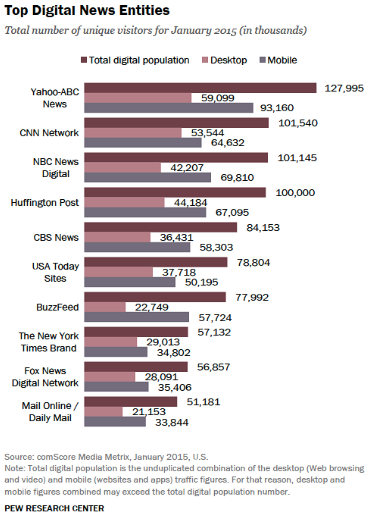
There's probably a good chance that you're reading this on your cell phone. The latest findings from Pew Research Center seem to indicate as much, anyway.
The center published its annual "State of the News Media" report early Wednesday, aiming to provide a clearer portrait of an industry that continues to grapple with seismic changes. Chief among those shifts: how online readers are consuming their news.
Analyzing data from January, Pew's researchers found that 39 of the top 50 digital news websites drew more traffic from mobile devices than from desktop computers. Among the 20 most heavily trafficked digital entities, only three sites -- BBC, CNET.com and MSN News -- drew more desktop visitors than mobile.
"Call it a mobile majority," the researchers wrote.
This trend is particularly striking at Yahoo-ABC News, the most visited digital entity for the month of January. Among its more than 127 million unique visitors that month, Yahoo-ABC drew more than 93 million from mobile, compared with more than 59 million from desktop.

Those findings reflect changing consumer habits, but they also might say something about the efforts by news outlets to accommodate that mobile consumption. It hasn't been an easy transition for some traditional outlets -- including the New York Times, which has experienced setbacks in the last year with a pair of its own mobile apps.
Those struggles notwithstanding, the newspaper's online readership has also gone mobile. According to Pew's report, the Times still pulled in more mobile visitors (nearly 35 million) than desktop visitors (29 million) in January.
Pew's study did include one cautionary note for online publishers (not to mention reporters): desktop visitors tend to spend more time on the sites than mobile visitors.
"For half of these top 50 news sites -- which include legacy print, cable, network, international and public broadcasting outlets as well as digital-only entities -- visitors from desktops stay longer than those coming through mobile," the report's authors wrote. "The reverse is true for only 10 of the sites, while for 15 sites the time spent is roughly equal."
Other notable findings from Pew's study:
- How did television newscasts fare in 2014? It depends. "Network television news saw a second straight year of audience growth (5% in evening and 2% in morning), for a combined average evening viewership of roughly 24 million," the study's authors wrote. "Cable news on the other hand, had another rough year, with prime-time median viewership down 8% across the three channels. Fox News fared the best, but still saw a 1% decline year over year." As usual, Fox News was the top performing cable outlet, but noted that it also saw a 1% decline.
- The "Serial" podcast, which debuted in October, emerged as an enormous hit. But 2014 was a strong year for the entire digital medium. "Podcast listening is on the rise, which could breathe new life into audio journalism," the authors wrote. "NPR's podcast downloads alone grew 41% year over year, according to the company's internal data."
- Hispanic outlets struggled in 2014, a problem that Pew said was a result of "the complexity of trying to reach a population that is both growing and becoming more native-born, with greater usage of the English language." According to Pew, print circulation dipped at the "three long-standing Hispanic daily papers," while Univision, the top Hispanic television network, "saw audience declines for its signature national news programs after record highs in 2013."


